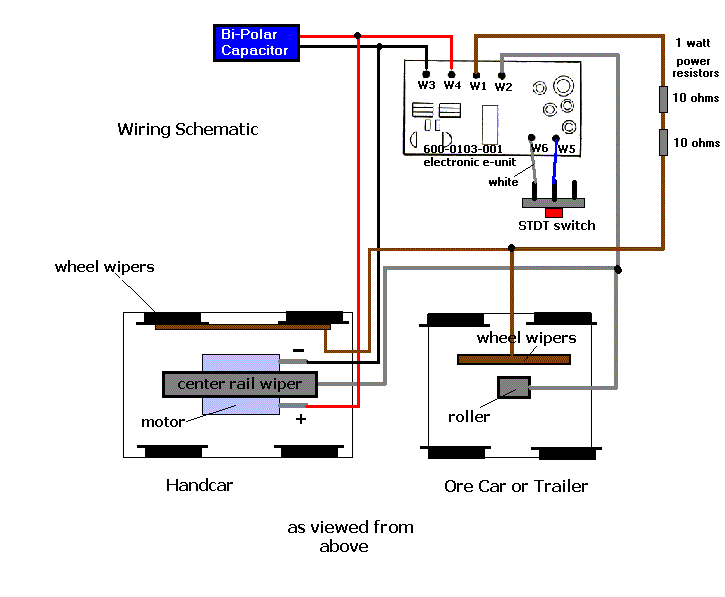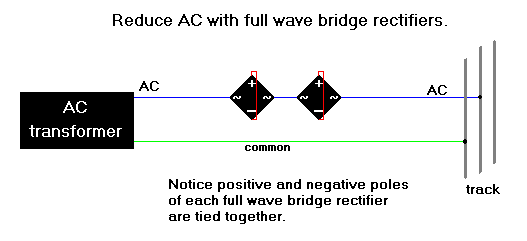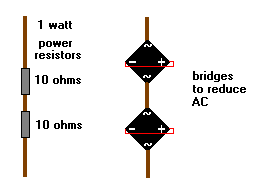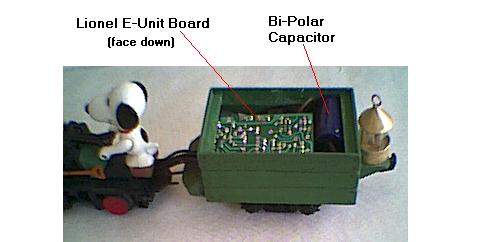Practically Invincible!!!
The Electronic Flywheel Effect
with a Lionel 600-0103-001 Electronic Reversing Unit
and a Bi-Polar Electrolytic Capacitor,
for a Lionel Handcar
It now just glides along, in both directions!!!!
 My latest project (Feb. 2010) with a Lionel handcar is simply wiring a bi-polar electrolytic capacitor to the Lionel reversing board (the e-unit rectifies the track current and reverses the polarity of the DC to the motor) that I added earlier to a handcar in a homemade trailing ore car. Remember that regular electrolytic capacitors are polarized components that always need to be connected with the correct polarity, so a regular cap can't be used with a reversing board. But bi-polar caps will handle the reversed polarity of the Lionel reversing board. So in this case with a handcar, a bi-polar cap rated at 16 V, 3300 mfd is just about under the absolute limit for safe use at about 9 volts, so it must be used with caution. But it does work very well providing some nice split-second coasting, just enough to handle some rough or dirty track, or problem area through a switch (turnout) or crossover. So now there is a flywheel effect (or brief coasting), in addition to the full "forward-neutral-reverse, etc." cycling of the e-unit. Although I can't say this technique will work will all the electronic reversing boards, it does with this one. But remember this is a bi-polar capacitor that needs to be used with caution and rated correctly for your project! Be sure to supply no more than 9 volts to protect the capacitor. You'll find the handcar will now run very well on about 7 VAC, so you may want to limit the output of a large AC transformer for this handcar. [Two 10 ohms 1 watt power resistors were added, 2 in series (see diagram above), to help eliminate "jack rabbit" starts. Increase or reduce resistance to fine-tune the speed to your liking. If resistors become too warm, increase the wattage rating. If space permits inside the ore car, a couple bridges, wired like those in the diagram below, could be substituted for the resistors.] Remember to wear face and eye protection when testing this circuit, and the capacitor should never get warm. Be sure to give the handcar frequent breaks to prevent overheating. You may want to use a separate, lighter AC transformer for better low-speed control when operating this altered handcar on a layout, and to assure that voltage stays within the safe range. Here is a very useful circuit for AC trains, for dropping AC voltage using a bridge rectifier. The Lionel electronic reversing board does seem to run a bit hotter with the addition of the bi-polar capacitor.
Yes, AC in and AC out:
http://home.cogeco.ca/~rpaisley4/xACdropper.html
My latest project (Feb. 2010) with a Lionel handcar is simply wiring a bi-polar electrolytic capacitor to the Lionel reversing board (the e-unit rectifies the track current and reverses the polarity of the DC to the motor) that I added earlier to a handcar in a homemade trailing ore car. Remember that regular electrolytic capacitors are polarized components that always need to be connected with the correct polarity, so a regular cap can't be used with a reversing board. But bi-polar caps will handle the reversed polarity of the Lionel reversing board. So in this case with a handcar, a bi-polar cap rated at 16 V, 3300 mfd is just about under the absolute limit for safe use at about 9 volts, so it must be used with caution. But it does work very well providing some nice split-second coasting, just enough to handle some rough or dirty track, or problem area through a switch (turnout) or crossover. So now there is a flywheel effect (or brief coasting), in addition to the full "forward-neutral-reverse, etc." cycling of the e-unit. Although I can't say this technique will work will all the electronic reversing boards, it does with this one. But remember this is a bi-polar capacitor that needs to be used with caution and rated correctly for your project! Be sure to supply no more than 9 volts to protect the capacitor. You'll find the handcar will now run very well on about 7 VAC, so you may want to limit the output of a large AC transformer for this handcar. [Two 10 ohms 1 watt power resistors were added, 2 in series (see diagram above), to help eliminate "jack rabbit" starts. Increase or reduce resistance to fine-tune the speed to your liking. If resistors become too warm, increase the wattage rating. If space permits inside the ore car, a couple bridges, wired like those in the diagram below, could be substituted for the resistors.] Remember to wear face and eye protection when testing this circuit, and the capacitor should never get warm. Be sure to give the handcar frequent breaks to prevent overheating. You may want to use a separate, lighter AC transformer for better low-speed control when operating this altered handcar on a layout, and to assure that voltage stays within the safe range. Here is a very useful circuit for AC trains, for dropping AC voltage using a bridge rectifier. The Lionel electronic reversing board does seem to run a bit hotter with the addition of the bi-polar capacitor.
Yes, AC in and AC out:
http://home.cogeco.ca/~rpaisley4/xACdropper.html

 If room permits inside the ore car, substitute bridges for power resistors in the first diagram on this page.
If room permits inside the ore car, substitute bridges for power resistors in the first diagram on this page.
 The board and bi-polar capacitor in the ore car, the cover removed.
It is a tight fit, but use the largest (in terms of its voltage rating) bi-polar cap possible. The little switch in the schematic above is for locking the handcar in the forward only mode (done when the handcar is operating in the forward direction). The switch is mounted underneath the little ore car. This particular electronic e-unit works on both DC and AC. The addition of this bi-polar capacitor with the e-unit makes the handcar practically invincible!
The board and bi-polar capacitor in the ore car, the cover removed.
It is a tight fit, but use the largest (in terms of its voltage rating) bi-polar cap possible. The little switch in the schematic above is for locking the handcar in the forward only mode (done when the handcar is operating in the forward direction). The switch is mounted underneath the little ore car. This particular electronic e-unit works on both DC and AC. The addition of this bi-polar capacitor with the e-unit makes the handcar practically invincible!
 This is the bi-polar electrolytic capacitor. It looks just like a regular polarized electrolytic capacitor, but is a little larger. Please don't mistake the one for the other!
This is the bi-polar electrolytic capacitor. It looks just like a regular polarized electrolytic capacitor, but is a little larger. Please don't mistake the one for the other!
 Dimensions of the ore car made from sheet styrene, the truck with a snap-in for electrical pick up is mounted beneath. It may be helpful to slightly elongate the ore car for a little more room inside for future expansion.
See my article
"Halt Handcar Hang-Ups!" offered now as a free sample from Kalmbach Publishing and Classic Toy Trains Magazine, for more details on a similar project.
Dimensions of the ore car made from sheet styrene, the truck with a snap-in for electrical pick up is mounted beneath. It may be helpful to slightly elongate the ore car for a little more room inside for future expansion.
See my article
"Halt Handcar Hang-Ups!" offered now as a free sample from Kalmbach Publishing and Classic Toy Trains Magazine, for more details on a similar project.

Very Important !!!!
The site owner is not and cannot be held liable for fire, electrical shock, property damage, bodily injury, loss of life, or accident of any kind caused by electrical circuits or any ideas, projects, techniques, or information contained on this site.
The visitor assumes all risk and responsibility for any loss, injury, accident or damage arising from the use of information, ideas, techniques, projects, concepts, components, products, and circuits on this site.
Please refer to hobby reference materials for correct and safe use information
regarding these and all electronic circuits. These diagrams are intended to explain how things were accomplished in theory, but it is the
responsibility of the individual to locate precise information regarding electrical circuits, materials, ratings of components, etc. Do not attempt
these hobby projects, or any electrical project, if you don't have the necessary skills and experience.
[Links to all handcar project pages]
Your handcar is now a locomotive!
So why all the fuss with the handcars? It is all about improving performance and obtaining good control -- to eliminate stalling and achieve forward and reverse travel which handcars won't do in their original manufactured condition. (It may be surprising to those familiar with model trains that a handcar doesn't travel in reverse in its original condition.) A handcar, with a "can" motor, will operate so smoothly on 6 volt DC from a lantern battery that you'll wonder why they aren't quite as good on rectified AC. Well, as someone explained to me years ago, the DC from a battery is very smooth, perhaps the purest form of DC. Rectified AC, unless it is filtered, still lets some AC past the rectifier. A capacitor smoothes out the DC in a filtering circuit in a powerpack. In a handcar, it is just the little rectifier between the motor and the AC from the track. For the flywheel effect, the cap not only filters, it discharges when there is an interruption in power to the motor from dirty or rough track, or from a purposely dead section like those brief pieces in a switch or crossover. As the capacitor discharges, it keeps the motor turning for a split second, or longer. And the cap will discharge when power is intentionally cut.
Unless you operate a handcar with the flywheel circuit, you'll never fully appreciate the improvement in operation. On a layout with switches and crossovers, an unaltered handcar may have trouble under the best circumstances. Add in some older, worn track and usual dead spots, then a handcar won't navigate what your most temperamental engine can do with ease. But with these improvements, the handcar runs very well, just by adding the reversing board and bi-polar cap in a trailing car. The original drive mechanism and motor of the handcar are unchanged, just the electronics are added and electrical pick up is extended over a broader area. (But just adding the trailing ore car isn't enough, but better.)
If you want full control like a locomotive, then you'll need to make the change. Capacitors have their failings, but used with reasonable care, they are great. And with a coupler on a handcar, you can actually shuffle cars around. There is a great sense of satisfaction when you have such nice control. And the handcar seems to just glide along!
(It has been said that the Lionel handcars are the most temperament of all, but Lionel has the best cartoon characters.)
If you want to remove the rectifier and just run it on DC, then you'll get bi-directional travel, but you can't run it on AC anymore (or you may add a tiny switch to bypass the rectifier for reversing with DC and still maintain AC operation when the rectifier is not bypassed). You may wonder why we toy train people run on AC when DC would give us such great control just by reversing polarity. Well, it is about backward compatibility and some features like blowing a whistle from a transformer button (which uses a little DC on the AC rails), and a few other advantages. I wanted to be able to have full layout access while running other AC trains, so this change was necessary. (For unaltered handcars, the addition of a resistor (approx. 10-16 ohms) in series with the motor will reduce a handcar's speed to a more manageable level, especially with older transformers where output starts at about 7-8 volts.) Essentially, your handcar is now a locomotive!







